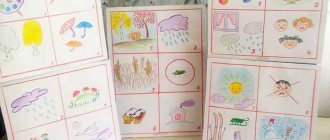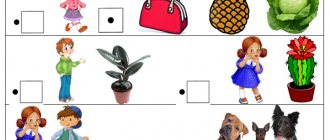The purpose and objectives of educational work in a speech therapy group
Educational work in a speech therapy group differs from educational work in a regular preschool group in that it is interconnected with correctional activities that are organized with children with various speech disorders.
In addition, children of the logogroup quite often, in addition to speech deviations, also have minor developmental deviations. Based on these characteristics, educational work should be built. Note 1
The goal of educational work in the speech therapy group: comprehensive and complete development of preschool children, taking into account their age and individual capabilities and needs.
Objectives of educational work:
Are you an expert in this subject area? We invite you to become the author of the Directory Working Conditions
- Children's assimilation of generally accepted rules and norms of behavior.
- Achieving stable results in mastering the general education program.
- Formation of moral and aesthetic qualities of the individual.
- Developing skills to maintain and strengthen one’s own health and the need for a healthy lifestyle.
- Formation of stable communication skills for successful interaction with others.
- Organization of an effective subject-development environment that promotes the overall development and personality development of preschool children, as well as the full development of speech.
Achieving the set goals and objectives of educational work in the logogroup is carried out through the professional activities of the teacher. That is why it is important that all teachers working with children constantly improve their knowledge and skills by studying pedagogical and methodological literature, attending advanced training courses and familiarizing themselves with the practical experience of their colleagues.
Technologies of educational work
Technologies of educational work in a speech therapy group:
Finished works on a similar topic
Course work Educational work in speech therapy groups 430 ₽ Abstract Educational work in speech therapy groups 260 ₽ Test work Educational work in speech therapy groups 190 ₽
Receive completed work or specialist advice on your educational project Find out the cost
- Gaming technologies are aimed at developing children's imagination, memory, attention, and speech. During the game, children have the opportunity to “assume” various roles, thereby learning to build relationships with other children and interact in a team. Gaming technologies are one of the most effective educational tools, since play for preschool children is the leading activity.
- The technology of integrated classes is a complex of different classes combined into one on equal terms. Integrated educational activities contribute to the development of children's moral qualities, aesthetic feelings, spiritual and moral sphere, creative potential, etc. That is, classes of this plan allow the teacher to significantly save time and at the same time obtain high educational results.
- Computer technologies are one of the most effective ways to increase motivation and individualize the educational process. When using computer technologies in educational work, the teacher is given a unique opportunity to create an interesting and educational lesson, a favorable emotional background and the all-round development of children. Classes using ICT are always interesting and exciting, and therefore the effectiveness of the educational impact on children is much higher.
The educational work in the speech therapy group firmly includes correctional classes on speech development. This is due to the fact that the development of speech in such a group is the leading direction that “permeates” all educational activities. Based on this, educational work is carried out not only in its “pure form”, but also in the process of implementing correctional classes on speech development, as well as at special moments.
The organization of educational work in a speech therapy group is carried out in the following forms:
- Group – work with several children, having a specific goal set based on the existing educational problems of these children.
- Individual – aimed at working with a specific child, based on his age characteristics and educational needs.
- Collective – work with the whole group, taking into account the characteristics of this category of children.
Methods and techniques of educational work in the logogroup:
- reproductive method: exercises, demonstration, explanations;
- verbal methods: conversations, riddles, reading, poetry, etc.;
- partial search methods: observation, examination, experimentation, research, etc.;
- project method: work on projects (short-term, long-term);
- a variety of techniques aimed at creating situations of success.
Independent website about stuttering
Speech therapy work
is given very important, transformative significance in a comprehensive medical and pedagogical approach to overcoming stuttering.
The main goal of speech therapy work
is the re-education of incorrect speech and behavior, the elimination
of psychological abnormalities in children who stutter
. The task of a speech therapist is to use pedagogical means to educate a stuttering child, on the one hand, the skills of correct speech, and on the other hand, a harmoniously developed, full-fledged personality.
The tasks of developing the skills of free, correct speech. The specific tasks of a speech therapist are to develop correct speech skills
: leisurely pace, sufficient volume and expressiveness, correct speech breathing, reliance on vowel sounds.
When developing free speech, first of all, it is necessary to develop a leisurely pace in the child, i.e. the ability to speak slowly, slightly slowly. what children who stutter most often do not know how to speak.
, since speech is an unpleasant burden for them. They try to unnoticeably “slip through” the obstacle that has arisen, get rid of it, and try to do it quickly. A fast pace provokes impaired coordination of speech movements and the appearance of speech spasms.
The leisurely pace of speech is developed simultaneously with the leisurely pace of the child’s general movements. Calm, balanced behavior in conversation and in non-speech activities helps to develop a certain tempo of speech. The ability to cope with anxiety, extinguish excitement, normalize affective states in a stuttering child
also contributes to this goal.
When instilling a leisurely pace of speech in a child, the speech therapist pays attention to preserving its expressiveness and naturalness. A child who is fluent in speech enjoys his speech; when conveying his feelings, he involuntarily uses a wealth of intonation and facial and gestural means. Stuttering deprives a child of this opportunity. Lack of incentive and desire to speak, fear of verbal communication often leads to the fact that the child’s speech
becomes dull, lethargic, quiet, inexpressive. Therefore, in the process of speech therapy work, the speech therapist attaches great importance to educating the child’s ability to speak loudly, expressively, confidently, and correctly use logical stress, raising and lowering the voice, and facial and gestural means.
In the education of correct speech, the normalization of speech breathing is also important, since in people who stutter it is usually superficial, harsh, restless, and short. There are often cases when individual sounds and words are pronounced by a child while inhaling.
In speech exercises, the speech therapist pays attention to the fact that the child pronounces words together in phrases, i.e. not each word separately, but all together, as one big word. This is explained by the fact that people who stutter
It is usually difficult to start speaking, and therefore the fewer scattered words he utters, the less difficulty he will have.
Teaching how to isolate vowels in a word (reliance on vowel sounds) becomes important for those children who have speech convulsions
on consonants. Pronouncing some vowel sounds (baaabushka, goorod) in length makes speech easier and relieves speech cramps.
When developing correct speech, the speech therapist simultaneously and, if necessary, works to correct pronunciation deficiencies
, expanding vocabulary, improving grammatical structure, developing the ability to correctly and consistently express one’s thoughts and desires.
The tasks of raising a harmoniously developed personality. No less important is the other side of speech therapy work - the elimination of possible psychological deviations in children who stutter, the development of a correct attitude towards their defect, towards themselves, towards their place in the team, towards others, the development of correct behavior in the team, as well as the development of their intellectual abilities, ethical and moral ideas.
For this purpose, the speech therapist widely uses methods of explanation, persuasion, suggestion and training in his work. Explains to children in an accessible form why their speech is difficult (hurries in conversation, breathes incorrectly, pays too much attention to their speech, is embarrassed by others, etc.). The mechanism of stuttering is explained to school-age children in an accessible form.
, techniques for overcoming it, etc. The speech therapist needs to convince the child that there is nothing shameful or terrible in his incorrect speech. To more successfully get rid of incorrect speech, you need to take care of yourself: take your time, speak loudly, calmly, confidently, pronounce vowel sounds more clearly, etc.
The speech therapist must constantly convince the stuttering child
is that he can speak well, freely, to inspire him that every day he speaks better and better. To do this, using simplified forms of speech, the speech therapist demonstrates to the child his own free speech: “You see, you just said well, correctly. You can speak well and freely. You just need to take your time in conversation (or: speak loudly, boldly, expressively, etc.). Now you can always speak well if you try.”
The speech therapist must be attentive to the state of the child’s speech
and celebrate its positive aspects at every lesson. Each speech lesson should bring the child a feeling of satisfaction from his correct speech and from the success he is making.
Constant fixation on success not only stimulates the child for further studies, but also gradually displaces his thoughts about his inferiority, contributes to the emergence of confidence in his abilities and a positive outcome of his studies. Thus, there is a gradual restructuring of his attitude towards his defect, towards himself, towards others, his characterological traits change for the better.
So, developing the skills of free, correct speech and a harmoniously developed personality are the two main tasks of speech therapy work with people who stutter.
IN AND. Seliverstov “Stuttering in Children”
This is interesting:
Self-massage techniques to eliminate stuttering. General information
Massage is performed to relieve tension and stiffness of speech and facial muscles and, conversely, to increase the tone of weak and flaccid muscles. To relieve tension from your face and relax it, you can use so-called self-massage. Here we will get acquainted with its two types: hygienic and vibration. Hygienic massage is performed by stroking, which activates the nerve endings located close to the skin. This massage has a dual role: it relieves tension and stiffness in the facial and facial muscles and increases the tone of these muscles if they are weak.
read more >>
Training speech muscles
Good diction is the basis for clear and intelligible speech. Clarity and purity of pronunciation depend on the active and correct functioning of the articulatory (speech) apparatus, especially on its moving parts - the tongue, lips, palate, lower jaw and pharynx. To achieve clarity of pronunciation, it is necessary to develop the articulatory apparatus with the help of special exercises (articulatory gymnastics). These exercises help create a neuromuscular background for the development of precise and coordinated movements necessary for the sound of a full voice, clear and precise diction, prevent the pathological development of articulation movements, as well as relieve excessive tension in the articulatory and facial muscles, develop the necessary muscle movements for free use and control of parts of the articulatory apparatus.
read more >>
Muscle relaxation
Most people who stutter experience feelings of anxiety, uncertainty, and fear in the process of verbal communication. They are characterized by an imbalance and mobility between the processes of excitation and inhibition, and increased emotionality. Any, even minor, stressful situations become excessive for their nervous system, cause nervous tension and intensify the external manifestations of stuttering. Many people who stutter are known to speak freely when they are calm. A state of calm is mainly ensured by general muscle relaxation. And vice versa, the more relaxed the muscles, the deeper the state of general peace. Emotional arousal weakens with sufficiently complete muscle relaxation.
read more >>
Self-massage to eliminate stuttering
Relaxing the neck muscles Relaxing the neck muscles reflexively relaxes the muscles of the root of the tongue. Exercise 1 Slowly stroke your neck from top to bottom in the throat area with the palm of your right or left hand. Exercise 2 Slowly stroke the neck at the same time with the palms of both hands from above from the parotid area of the face along the lateral surfaces of the neck to the armpits.
read more >>
‹ Tasks and forms of therapeutic and health work Up Stuttering in children. Conclusion >







